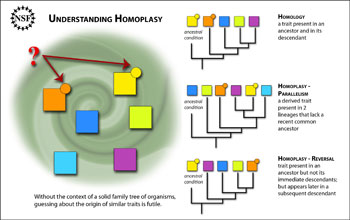Multimedia Gallery
Studying Homoplasy
This graphic explains homoplasy, a fascinating and unusual occurrence in evolution where there is an independent acquisition of the same trait in unrelated lineages.
To understand whether multiple organisms share the same trait because of homoplasy, their places in the evolutionary tree of life must be defined. Parallelism/convergence homoplasy occurs when the same trait is present in two lineages that lack a recent common ancestor. Reversal homoplasy occurs when a trait is present in an ancestor but not its immediate descendants--but appears later in a subsequent descendant.
To learn more about this research, which was supported by the National Science Foundation (NSF), see the NSF press release "Homoplasy: A Good Thread to Pull to Understand the Evolutionary Ball of Yarn."
Credit: Zina Deretsky, National Science Foundation
Images and other media in the National Science Foundation Multimedia Gallery are available for use in print and electronic material by NSF employees, members of the media, university staff, teachers and the general public. All media in the gallery are intended for personal, educational and nonprofit/non-commercial use only.
Images credited to the National Science Foundation, a federal agency, are in the public domain. The images were created by employees of the United States Government as part of their official duties or prepared by contractors as "works for hire" for NSF. You may freely use NSF-credited images and, at your discretion, credit NSF with a "Courtesy: National Science Foundation" notation.
Additional information about general usage can be found in Conditions.
Also Available:
Download the high-resolution JPG version of the image. (293 KB)
Use your mouse to right-click (Mac users may need to Ctrl-click) the link above and choose the option that will save the file or target to your computer.

